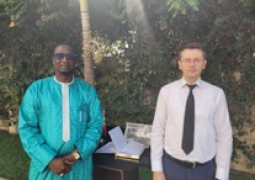The book is divided into nine short but concise chapters which discuss comprehensively the story of Western education in The Gambia from the 1820s to the more modern period. In chapter one, Introduction, the author discusses the religious and political and social context in which Western education thrived in the country. The British colonial structure of indirect Rule where you had the Colony and Protectorate influenced the spread of Western education. The Colony had better access to schools much earlier(page2). The context of Christianity and Islam was also significant in the development of western education in The Gambia. The author explains on pages 3-8 that Islamic education was already taking firm root before the 1820s, meaning that the British did not find a completely illiterate populace when they were building the first Western schools in the 1820s. Western education, therefore, benefitted from the literacy tradition of Islamic education, which predated it.
In chapter two, the author traces the tenuous roots of Western education in what is today called The Gambia. He narrates that it was exactly 200 years ago that the Quakers William Singleton and Hannah Kilham set up a school for the new settlement of Bathurst at Bakau, where the Headman was kind enough to give them a plot of land to set up a school for boys and a school for girls. This separation of the sexes was due to the dictates of Victorian prudishness than to religious obligations. But it is clear from the involvement of the Quakers, who are a branch of the Anglican church, that early Western education was largely, and in fact, the business of missionary societies.
In chapters three and four, the author explains the missionary factor in the spread and attainment of Western education in The Gambia, including the good work of the Catholic, Anglican, Methodist and Ahmadiyya in spreading Western education through the establishment of schools and training of teachers. The author contends in these two chapters that during the colonial period from 1889 to 1965, Western education spread and grew despite government support and attention. The leitmotiv in these chapters is that the success of the spread of Western education is linked directly to missionary influence and support.
In chapter four, in particular, the author highlights the bottlenecks missionaries faced in their quest to spread Western education, including social taboos and religious suspicion. The missionaries found that the soil was too rocky to allow Christianity’s seed or its corollary in many areas. Western schools to germinate or sprout.
In chapter five, the author painstakingly takes us through the multiple attempts by the colonial and post-colonial states to literally paper over or policy over the shortfalls in access to education. Through numerous Ordinances as far back as 1882(page41), to Reports, Studies, Policies, you name it, what the state was unwilling or unable to do to educate the people, it hid in lengthy paperwork which few people read and therefore had little impact on the ground, with each new paperwork commissioned by the colonial rulers, the stronger the subterfuge the Colonial government to study the state of education, the stronger the subterfuge not to do anything. A notable exception was the 1882 Ordinance which created the Board of Education, and the Gwilliam Report of 1957(page 49), which promoted the involvement of women in educational administration.
Chapters 6 and 7 tackle more recent issues related to examination Boards, private and international schools’ madrassa and university and vocational training. These emerging issues show that any society's history of education, however small, is always evolving and taking new twists and turns, weaving intricate patterns of numerous dimensions and distances.
To the credit of this book, aside from the very eloquent narrative, this book is a complete book replete with a reference, footnotes, and an index, with suitable and relevant appendices to boot. This shows that a high degree of meticulous research made this work. Moreover, the print is clean and reader-friendly.
But beyond the issues of format, this book can also help chart a course for our education planners as they continue to scour the horizon for an educational system and situation more suited for our development. Therefore, it is a suitable handbook for not only aficionados of history like me but also educationists and teachers.
In a future new edition of this book that should happen quickly, I suggest that Kristikunda, Armitage and Muhamedan schools get a special new chapter for the great roles they played in Western education in our country. I also suggest that the Gambia Teachers Union, established in 1938, get a special chapter for its wonderful roles in teacher mobilisation.
It is highly recommended as an exciting work on an important topic in Gambian history.



